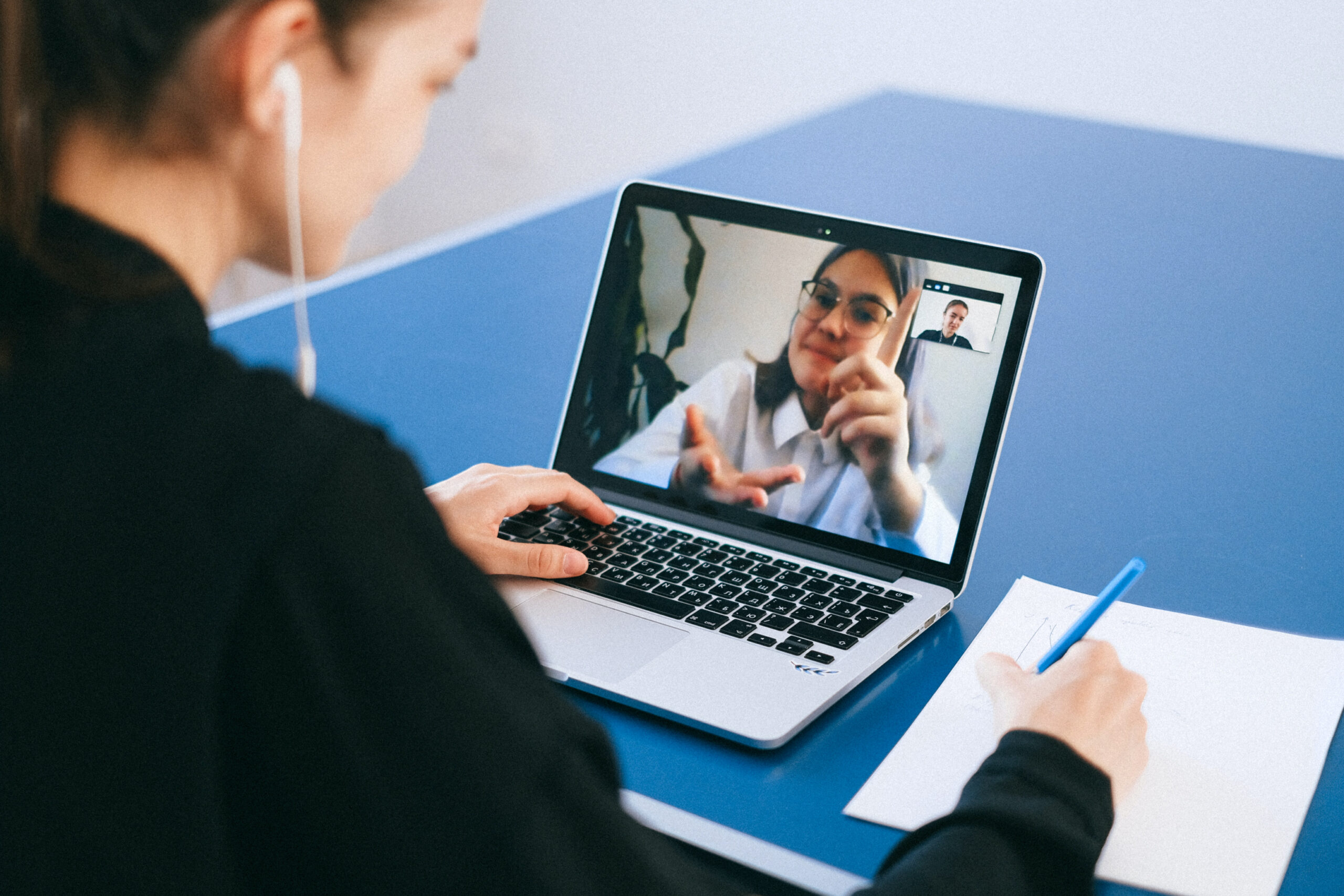Tips to prepare for an online job interview
The preparation for online (or virtual) job interview has some similarities to preparation for an in person interview. There are, however, some significant differences that need to be considered. For example, instead of going to an employers office, they are coming into your home, virtually anyway. This means that you have more responsibility in preparing for the interview.
Study for an online job interview like you would for an in-person interview
In addition to researching the company and preparing answers to common interview questions, you should also think about questions specifically related to working remotely. For example: Have you ever worked remotely before? How will you engage with your team virtually? What do you feel are the greatest challenges about working from home, and how will you overcome them? Don’t forget to come up with questions to ask your interviewer as well.
Be sure to look up proper names beforehand so that you know their pronunciation.
Dress for an online job interview like you would for an in-person interview
When you get dressed for a video interview, dress as formally as you would be for an in-person interview. Be sure to dress from top to bottom. If you have to get up to grab something, you don’t want the interviewer seeing you in pajama bottoms. It does not create confidence that you are capable of taking your work seriously.
Make sure your outfit looks good on camera and doesn’t get lost in or clash with your background. If you wear a lower cut top, make sure that the top of that shirt shows in the video frame. Otherwise, it’ll look like you’re topless. Avoid any overpowering patterns or flashy accessories.
Eliminate potential interruptions
Nothing looks more unprofessional than a pet, child, or spouse moving in the background of your job interview. While your interviewer may be understanding, getting interrupted is just like being late for an interview. Everyone knows interruptions happen. Your ability to prepare ahead to avoid that situation demonstrates you’ll be prepared for challenges on the job. If you demonstrate that you can’t control interruptions, an employer may question whether you can handle professional online meetings.
Though this interruption is funny to watch, you probably wouldn’t hire this guy for your company.
Be sure to turn off or silence your phone or any other electronic device that might make noise. You should also pause any notifications on your computer.
If there’s a chance of you being interrupted by something outside of your control, mention it at the start to prepare your interviewer and show them you’re proactive. For example, if you have a dog in the next room that might start barking when the mail is delivered, make your interviewer aware of that possibility.
Manage the set of your online job interview
It’s important that your background communicates professionalism, especially if the position will require video calls and conferences. Just as you dress and rehearse your presentation for the interviewer, you have to stage the setting for your interview. The interviewer might easily be distracted by something in the background or, worse, see something that they find disagreeable.
The messier the background, the harder it is to convince a hiring manager of how detail-oriented and organized you will be as an employee. Notice in the video above, that the newscaster covered the bed with a white sheet and put books on top of it to make it appear to be a desk, until his daughter sat on the bed and gave away the ruse.
Remove any items that indicate religious or political beliefs as they might be contrary to that of the interviewer. Of course, if you’re interviewing to be a cleric at a mosque, feel free to leave up the Allah Akbar banner on your wall.
Probably the safest option is to use a green screen behind you so that you can completely control the background. Many online video programs allow you to customize your background. Again, be sure to choose something professional. A background of you in an office is going to communicate more professionalism than a background of you on a beach or a roller coaster. You want to leave the interviewer with the impression of how you will look when working for him.
Manage your personal positioning
When you sit in your chair, make sure you don’t end up looking too tiny or too huge. Just as you wouldn’t sit a couple inches or several feet from your interviewer in a real life setting, don’t sit an uncomfortable distance from your computer. To look well proportioned, make sure there’s a bit of empty space on the screen above your head and check that your shoulders and upper chest are visible.
Make sure you’ve found a comfortable distance that allows you to look straight ahead
Manage your lighting
Before you’ve finalized your outfit and location, see if anything in your shot is reflecting or giving off a glare that might distract the interviewer. Again, observe how watches, jewelry, and eyeglasses look on screen. Solving the issue might be as easy as removing the accessory.
Test your lighting around the same time of day as your interview, especially if you’re using natural light to illuminate you. It is best to sit in front of a window so you are illuminated and not silhouetted.
Test your technology
Technical skills are considered one of the top competencies employers look for in new hires, and hiring managers are able to easily gauge your abilities during a virtual interview.
It’s important to be familiar with these popular video interview platforms, and make sure you test on the same device you’ll use for your interview. You may have Google Hangouts downloaded to your computer or phone, but Google has discontinued that app. Don’t forget to download the video software you will need and test it well beforehand. Here are the most commonly used applications for online job interviews:
- Skype
- Zoom
- Google Meet
- Microsoft Teams
Cut down on technical difficulties by testing out your setup ahead of time using the same platform, internet connection, and hardware you’ll be using for your interview. Make sure your mic is turned on, and know how to mute it!
If you have a portfolio or anything similar you’d like to be able to show via screen share during your interview, make sure that it’s ready in an easy-to-access, but minimized, window
Be sure to request the link and password (if required) to your virtual meeting so that you can sign on beforehand.
It may seem like overkill, but be sure to secure your internet connection by making sure there is nothing that is going to disconnect your modem, like a pet or child. Nothing stifles a conversation like a call dropped mid-persuasion point.
Do a practice job interview ahead of time
Probably the most important thing for a virtual interview is the same as it is for an in-person interview: practice! Set up a mock video interview with a friend.
Hopefully they can tell you if you have a tendency to look away from the camera or if your hand gestures are too low to be seen.
Ideally, record your practice to learn if you’re making eye contact, fiddling with papers, or your posture is bad. During your practice, take note of how fast you speak, how you pause, and the tone and pitch of your voice.
Immediately before the interview
Have a glass of water nearby as you may get a dry throat from talking. You don’t want to get up to leave the room during the interview any more than you would during an in person interview.
Have a pen, notepad, questions and your resume in front of you. Write down key figures and other small snippets, not whole answers. You can use post it notes to paste them to the side of your computer. If seeing yourself is going to be a distraction, try covering up your image with a sticky note as well.
You should be ready when the interview starts, not getting ready. You wouldn’t walk into the building at 3 PM for 3 PM interview or even at 2:59 PM, so don’t cut it close with a video interview either. Ideally, you should probably make sure everything is up and ready 20 minutes beforehand.
During your online job interview
Don’t be afraid to say if something feels off—if you can’t hear or see your interviewer well, for example. It’ll just demonstrate that you’re willing to speak up and be straightforward about issues.
Sit up straight and look at the camera lens (not the meeting pane). Sitting up straight naturally gives you a bit more energy and helps you communicate your excitement about the job. Looking at the camera makes it appear that you are speaking directly to the interviewer.
Everybody can look like a statue over video interview,” Turner says. You shouldn’t be so static that your interviewer has to wonder if you’re still connected. Instead of saying “mm-hm” or “yeah,” nod or smile when you’d usually speak. That way your interviewer still gets the feedback
Smile and use gestures when speaking to appear enthusiastic and pleasant. When listening, nod thoughtfully to show you are engaged. Finally, don’t forget to sit up straight; slouching will make you seem unprofessional, sloppy, and overly casual.
Be sure to only make quick glances to your notes and questions so as not to lose eye contact with your interviewer. Potential employers are more likely to remember what you said if you maintain eye contact, so be sure to keep your eyes focused on the camera.
An interview should be a conversation
The best interviews are conversations, Be more personable. Be yourself. You want to talk like you’re talking to someone you know well. Make sure your video call is “not just question, answer, question, answer, like a table tennis match. Look for their responses. You don’t want to sound like you’re just reading.
When your interviewer responds to your answers, feel free to comment on their responses if you have more to say. And sprinkle your own questions throughout your conversation whenever they’re appropriate rather than waiting for the end. You want your interviewer to see you as someone they could talk to every day, not like someone they are interrogating.
Let the Other Person Finish Speaking, internet lag, it’s not always immediately apparent whether someone is done speaking or just pausing. In the same vein, it’s helpful for the other person if you signal the end of your answer, especially if it’s a long one. You can do this through a visual cue like nodding or you can make sure you conclude your answer strongly or ask the interviewer a question.
Explain Any Long Pauses Because of the various limitations of video calls, it might not always be clear to your interviewer what you’re doing if no one is speaking. Tell them if you’re pausing to write down a few notes, pull up some information for them, or even just formulate your answer to a question.
Classes to help prepare you for your online interview
Pronunciation is what we specialize in at Packard Communications. For help with your communication and pronunciation skills, check out Packard Communications’ services page for an initial assessment, small classes, individual training, or online training! Either way, we can help you with your English pronunciation so that you are confident speaking personally and professionally.






